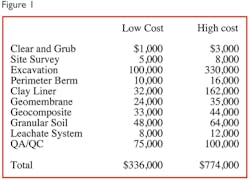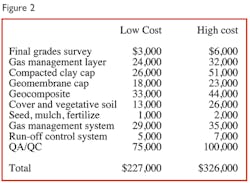Nobody has to tell a landfill operator how to be industrious. Hard work and long hours come with the job, a job that includes everything from balancing the books to personally operating heavy equipment, to meeting with an often hostile public and even to helping to pick up blow litter from around the landfill’s perimeter fence. A lazy landfill operator is a contradiction in terms.
But on top of the already heavy workload, today’s economic environment demands that landfill operators go that extra mile and practice equal amounts of frugality. Depressed economic times combined with ever increasing demands from stockholders to maintain and even increase profitability require a landfill manger to come up with new ways of stretching his budget dollar. The best way to do so is to extend the life of the landfill, squeezing out every current dollar of revenue while maximizing the efficient return on capital and operating costs.
Why Landfill Life Extension Is Now So Important
“Use it up, wear it out, make it do, or do without.” –World War II slogan.
Whether it’s hard times or wartime, the people who see it through are the ones who stretch their resources and make do with what they have. It is no secret that the economy in general and the solid waste industry in particular have been experiencing hard times since the financial meltdown of 2008.
According to Waste Business Journal (January 26, 2011): “The latest figures from the USEPA indicate that US waste generation of municipal solid waste (MSW) in 2009 declined by 3.2% to 243 million tons from 251 million tons in 2008, representing the second straight year of decline. The EPA’s figure is in line with statistics gathered independently by Waste Business Journal (WBJ) through direct survey of all waste processing and disposal operations across the US and Canada. According to WBJ, residential volumes of MSW declined by 3% from 2008 to 2009 but commercial wastes, accounting for 22% of the total wastestream entering municipal facilities, declined by nearly 18%. Construction-and-demolition waste alone was down by close to 20%.”
The economic downturn of 2008 accelerated a trend begun by 2005, when American waste generation peaked both in terms of total produced (252.7 million tons) and per capita (4.67 pounds per person per day). As of 2010, the latest figures from the USEPA show total municipal solid waste generation had declined to 249.9 million tons total and 4.43 pounds per day per capita (Municipal Solid Waste Generation, Recycling, and Disposal in the United States: Facts and Figures for 2010, USEPA).
It is a simple fact (often forgotten by those who do not operate a landfill) that a landfill is in business to make money. However, as described above, since the Great Recession that started in 2008, decreased economic activity has translated into declining tonnages of waste at the landfill’s gate. This in turn has depressed gross revenues, threatening profitability just as stockholders and corporate management demand ever increasing profits. This increased pressure to maximize profits in an environment of depressed revenues can only be achieved by minimizing costs. Certainly, an operator can cut back on hours, trim staff, and idle or sell off equipment. But for a landfill, the costs that matter most are capital costs.
Operating costs measured in dollars per ton of waste received are secondary to the large capital outlays needed to permit and construct the disposal cells, landfill gas collection systems, leachate pretreatment facilities, final cap and cover, access roads, onsite buildings, and the rest of the infrastructure that makes an operating landfill possible. Furthermore, the reduction in gate receipts caused by the economic downturn dry up the primary source of cash needed for capital investments. So the surest most direct path to minimizing costs is to extend the operating lifetime of the landfill in general and the current operating phase in particular, and by doing so delay the need to make these capital outlays-all the while meeting and exceeding all of the regulatory and safety standards for operating the landfill. Because at no time should a landfill operator equate cost savings with cutting corners or taking risks with environmental protection, personal health, or safety.
The Time Value of Money
“Time is money.” –Benjamin Franklin
So how does delaying the need to expend capital costs affect the overall financial well being of a landfill? In addition to minimizing current cash flows, the postponing of capital outlays reduces their true costs due to the effects of time and interest rates on the value of the money to be spent. In simple form, this is determined by the single payment, present value interest formula (PVIF):
P = F / (1 +i) N
Where,
P = the present (current) sum of money
F = the future sum of money
i = the interest rate per interest period stated in decimal for (5% interest is 0.05), usually stated in terms of the rate of return from zero risk investments like T-bills
N = number of interest periods usually measured in years but can also be of shorter duration, like months. Should periods of shorter duration be used, the applied interest rate should be equivalent to the annual interest prorated for the time periods in question.
For example, assume a landfill operator has a capital expense of $100,000 that has to be spent now or in the future. As a result of frugal management of the site operations, the operator can push the need for constructing this capital improvement back by five years. During this period a risk-free investment can expect to earn 5%. The PVIF factors are as follows:
P = to be calculated
F = $100,000
i = 0.05
N = 5
This results in a present value of:
P = $100,000 / (1.05) 5
P = $100,000 / 1.27628
P = $78,353
A five-year delay in capital outlays results in a current cost savings of $21,647. In practical terms, this means that an operator needs to put aside only about 80% of the projected capital cost into a risk free investment, let the magic of compound interest do its work and have the amount he needs when he needs it five years from now. The almost 20% savings can be used for other things or simply can be added to the bottom line to improve the site’s profit-and-loss statement for the current year.
But what about inflation-won’t it be more expensive to build the needed infrastructure five years down the road? Not necessarily. Current CPI trends show inflation-or even a threat of deflation (prices falling)-to be nonexistent. Such a situation makes delaying capital costs even more attractive. However, should the economy find itself facing resurgent inflation, this can be factored into the rate of return so that this value is net of inflation. For example, if inflation is projected to be 2%, the 5% rate of return would be net 3%, and this is the value to be used in the PVIF formula. (FYI, this lower net rate of 3% would result in a present value of $86,261, a still substantial savings of $13,739.)
Typical Costs
“You must spend money to make money.” –George Steinbrenner
The above example used an arbitrary figure of $100,000. But what kinds of real world costs are being postponed and what do they amount to? Landfills are unique in that they require high upfront capital costs but need relatively low operating costs (as measured per ton of waste received). We can assume that those initial costs incurred to get the landfill permitted and open for business have already been spent, including site investigation and hydrogeologic studies, engineering design and permitting, utility hook-ups, the construction of ancillary structures and facilities (offices, tool sheds, or repair shops), fencing, truck scales and scale houses, wheel wash, parking, and access roads.
The bulk of the remaining capital costs are associated with disposal cell construction, the installation of leachate and landfill gas collection systems, surface water runoff and sedimentation/erosion control structures, and final capping and closure. Based on cost evaluations preformed at landfills in the Midwest, Figure 1 provides a good summary of the range of costs associated with landfill cell construction (including installation of the leachate management system) on a per-acre basis.
Figure 2 provides the range of costs associated with final cap and cover, including landfill gas management system installation.
So, utilizing these cost figures, an acre of developed landfill will cost between $563,000 and $1,098,000, with an overall average of $830,00 per acre (see “Landfill Economics” Parts I, II and III, Daniel P. Duffy PE, MSW Management, 2005).
Why the wide variance? One of the main variables is the cost of excavation and/or placement of structural fill to establish the foundation for cell liner construction. The depth of excavation will typically be determined by local groundwater elevations and other hydrogeological factors. Ease of excavation will depend on types of soil (from hard, stiff clays to organic peat soils). So low-cost earth-work estimates will assume easy and shallow excavation, while the high cost range assumes the opposite.
But the real wild card cost is the expense associated with the purchase of geosynthetics, which in turn depends on the current cost of oil. Historically, oil shortages and the resulting price spikes have adversely affected the price of geomembranes, geonet, and geotextiles. Short of locking price orders with geosynthetic suppliers months or years in advance (an agreement difficult if not impossible to achieve), there is little that can be done to ensure a steady future cost of these materials. Fortunately, the cost of oil has leveled off and is even in an overall shallow decline-at least for the near future.
Methods of Extension
“You can’t do today’s job with yesterday’s methods and be in business tomorrow.”-George W. Bush
There are several broad categories of methods that can be used to extend the operational lifetime of a landfill. These include recycling waste materials (more garbage out, less garbage in) and diverting them to beneficial uses, and efficient and on-time use of disposal airspace.
Recycling
The most obvious method to extend the life of a landfill is to send it less waste to be disposed of in the first place. This diversion of waste from the landfill means increased recycling efforts. As of 2010, the US recycled slightly more than one-third (34.1% to be exact) of the municipal solid waste generated by Americans. This includes approximately 63% of paper and paperboards, 27% of glass, 35% of metals, and 28% of organic wastes. As a practical matter, the difficulty of achieving even higher rates of recycling for paper waste, and the lack of a strong market for the resale of recycled glass, would suggest that recycling efforts be concentrated elsewhere.
The lowest-hanging fruit, both in terms of ease of recycling and strong markets for the recycled materials, is scrap metal. Utilizing magnetic separators for ferrous metals and eddy-current separators for nonferrous metals, a high percentage of the metallic portion of the wastestream can be mechanically separated in a simple and straightforward manner. Though normally performed at a materials recovery facility (MRF), individual standalone scrap metal separators can be utilized.
The other category that could readily lend itself to increased recycling efforts is that of organic wastes. Unlike scrap metal, which usually requires separation form the wastestream after collection, organic wastes should be source-separated by homeowners. By removing lawn trimmings, leaves, and foodwaste from their household waste, homeowners can divert organic waste to be composted. Food scraps and yard trimmings can be composted by individuals on their property. Neighborhoods and institutions (universities, schools, hospital, supermarkets, businesses) can compost at central facilities. Municipalities can integrate source-separation of organic waste (prohibiting its disposal in landfills) and large-scale composting facilities in their overall municipal solid waste management plan.
Waste incineration is not also a potential source of energy, it should also be thought of a means of mass-scale bulk recycling of waste. Instead of individually separating out metals, plastics, organics, and paper for reuse as original materials, incineration recycles the entire waste mass into a new product: fuel for energy production. Incineration can reduce the overall volume of waste by 90%, leaving behind ash and metallic slag. Though this represents a significant reduction in the amount of waste sent to final disposal in a landfill, it also requires significant upfront costs associated with the construction and operation of the incinerator unit. So unless a regional incinerator is already up and running, this approach may cost more than it is worth.
Landfill mining can also be considered as a form of post-disposal recycling since it removes and reclaims primarily inorganic materials like scrap metals that have a significant market value that justifies the cost of mining. In doing so, landfill mining removes a percentage of the landfill’s volume, freeing up more air space and delaying the need for future capital expenditures. Landfill mining equipment can be rented for the duration of the operation (thus removing the need for capital costs) and usually consists of excavators and backhoes, magnetic separators, and vibratory screeners or rotating trommels for material separation. For large-scale mining operations conveyor belts or trucks for mass hauling, and storage bins for the extracted materials will also be needed.
However, care must be taken during mining operations as they risk potential damage to the landfill’s containment structures, and are inherently messy and unpleasant operations.
Efficient Airspace Utilization
Landfills sell disposal volume: empty air. The available volume of each operational phase is determined by allowable slope steepness, the extent of its lined area, ability to place waste over adjacent slopes, and its general configuration. As the volume of each operational phase is fully utilized, the site has to incur capital costs to construct the lined area and leachate management system of the next operational phase as well as the installation of final cover and landfill gas systems on the current phase. The key to increasing the lifetime of the current operational phase, and thus delaying the capital expenditures associated with the next phase, is maximizing the efficient use of available airspace. This means increasing the in-place density of deposited waste to the greatest value possible.
The municipal solid waste deposited at a landfill arrives with a density of approximately 20 to 25 pounds per cubic foot when dumped onto the workface. Standard waste compaction equipment and methods, cuts the volume of deposited waste in half as it doubles its in-place density to 40 or 50 pounds per cubic foot (equivalent to an average density of 0.6 tons per cubic yard). Provided that the amount of waste received each day remains the same, this in-place compaction doubles the potential lifetime of each cell compared to just spreading and placing the waste without compaction. But this operation is already standard at most landfills. What is needed is a more extreme approach to increasing waste density.
One such way is baling the waste and creating bale fills. Baling achieves a much higher density with an additional one-third reduction in waste volume. Instead of 0.6 tons per cubic yard, a baler can achieve densities of 0.9 tons per cubic yard, a 50% increase. Having greater internal strength than compacted waste, they are also more resistant to slope failure and can be stacked to form steeper slopes. This allows for more waste per unit area of line disposal cell, significantly increasing its operational lifetime. Being relatively imperious to wind and disease vectors, bale fills need little in the way of daily cover. However, baling operations can require a significant up front capital purchase of their own to obtain the bailing facility and equipment.
Dynamic compaction occurs at the extreme end of waste compaction efforts. It involves the dropping of heavy weights (15-20 tons) onto the surface of the fill from a height of 30 to 60 feet. The impact locations are arranged on a grid pattern whose spacing is determined by the weight being dropped and the nature of the waste (depth, age, etc.). Each impact induces a shock wave that propagates deep into the waste mass. The resultant in-place densities are so high that this technique creates foundations stable enough for commercial construction on the landfill itself. While the results vary considerably from site to site a tripling of standard compacted densities is achievable.
A gentler approach to maximizing airspace would be the extensive use of alternate daily cover (ADC) instead of soil to cover the landfill’s workface and intermediate slopes. At a minimum 6-inch thickness overlaying the waste, standard soil cover would not at first appear to take up a significant amount of volume. A landfill receiving 1,000 tons per day would use 1,667 cubic yards of airspace at standard compacted densities. Such a daily waste receipt would typically require a workface of almost a quarter-acre in area (10,000 square feet). The 6 inches of soil placed as daily cover would then consume 5,000 cubic feet (almost 190 cubic yards), increasing the daily airspace use to 1,857 cubic yards. Therefore, of the total airspace consumed each day, approximately 10% is consumed by cover soil instead of profitable waste disposal. This adds up to a significant volume, with a significant affect on the current phase’s operating lifetime. Either mechanically applied or sprayed on the workface surface, there are five broad categories of alternate daily cover to choose from: disposable sheets of thin plastic film, longer-lasting tarps made from high-density polyethylene (HDPE) or heavy geotextile, spray applications of inorganic chemicals like cement, or organic materials like pulped paper. In all cases, the use of ADC can reduce airspace utilization rates by at least 10%.
Design Changes
Not every life extension method directly involves physical field activities. Some require engineering analyses. For example, the current operational phase’s landfill disposal cell does not necessarily have to be built all at once. Instead of building an entire 10-acre disposal cell with a capacity of 10 years of airspace all at once in year one, enough of the cell can be built so as to accommodate half of its designed disposal capacity with the remainder of the cell built later in year five. Note that half the volume will not be provided by half the area. Depending on the overall geometry of the disposal cell and its ability to overlay adjacent waste slopes of earlier cells with additional waste, the amount of lined area needed to provide half the volume could be as high as two-thirds to three-quarters of the overall area. The relatively small remaining area provides the remaining half of the airspace, because waste can be placed overlaying the slopes of the initial partial phase area. In any case, there is always room for refining the development of individual phases so that their construction can be broken up and postponed into multiple sections.
More extensive design changes would require a permit revision that allows for an expansion of the overall landfill itself (horizontal, vertical, or both). In this case, either additional lined area is to be constructed or additional waste will be deposited on existing lined areas. Of the two options, the vertical expansion is the one with the greatest financial appeal for a landfill owner, as it requires little or no capital costs. Care must be taken during the design process to perform engineering analyses to ensure the continued stability of the now much higher waste slopes, making sure the dead weight from additional waste will not crush leachate collection system elements or cause undue settlement, or that increased runoff from steeper slopes will not exceed the capacity of existing surface water runoff management structures and detention ponds.
Radical Approaches
Accelerating natural waste decomposition as much as possible by introducing water and/or recirculating leachate through the waste mass would convert a standard “dry tomb” landfill into a bioreactor. A bioreactor design seeks to accelerate the decomposition of the organics portion of the deposited waste, which is often shredded prior to disposal to increase the amount of waste in contact with the liquids. Bioreactor landfill operations can be performed in coordination with landfill mining, since the subsequent reduction of organic waste volume makes mining much easier. There are three types of bioreactors: aerobic (using oxygen-based decomposition and relying on air injection performed simultaneously with leachate recirculation), anaerobic (using biodegradation in the absence of oxygen, and utilizing only recirculated leachate), and hybrid (using aerobic process in the upper waste layer and anaerobic methods in the bottom layers). Though theoretically able to act as an infinite landfill, with rapid decomposition followed by mining of inorganics continuously creating new air space for disposal, bioreactor landfills aren’t always acceptable to state regulators. It is also not practical to apply this approach to existing waste disposal cells, and its use in subsequent phases would require a major design change and permitting of the site.
Shredders are useful for reducing the size of such bulk items as tires, furniture, appliances, tree trunks, and automobiles. The resultant “fluff” is more easily handled, spread and compacted than whole bulk items that take up more space than their actual physical bodies. Shredding these objects eliminates these large void spaces, resulting in reduced volume. While a relatively small portion of the overall wastestream, bulk items can occupy excessive disposal volume while reducing the effectiveness of compacting nearby waste.
On the cutting edge of waste-volume-reduction techniques are those methods that convert waste to liquid fuel. These include plasma arc reduction, waste pyrolysis and gasification, the conversion of organic byproducts into fuel (aka, “turkey guts to oil”), and the conversion of bulk municipal solid waste to oil.
An industry leader in this last category is Enerkem of Montreal, Canada. Enerkem’s process could conceivably convert 168 million metric tons of nonrecyclable and noncompostable waste from North America’s annual municipal solid wastestream of 528 million metric tons and convert it into 16 billion gallons of ethanol. The company has validated its process over a period of 10 years. It currently produces cellulosic ethanol from waste residues at its demonstration facility and is expected to begin operation at its first full-scale commercial waste-to-biofuels facility in Edmonton, AB, during 2013. The company is also currently developing several full-scale commercial facilities, such as in Varennes, QC, and in the United States. Enerkem’s technology platform is a four-step thermochemical process that consists of feedstock preparation, gasification, cleaning and conditioning of syngas, and catalytic synthesis. This process uses proven, well-established, and commercially available catalysts to convert mixed waste and residues into a pure synthesis gas (or syngas) suitable for the production of biofuels and chemicals. With a platform of proprietary technology, the company is able to chemically recycle the carbon molecules from nonrecyclable waste into a number of products.
The primary focus is the commercial production of cellulosic ethanol. Its unique process first requires the production of methanol as a chemical building block for the production of ethanol.
Enerkem can also sell its methanol as an end product or use it as a key inter-mediate to produce other renewable chemicals.
The process uses relatively low temperatures and pressures, thereby reducing energy requirements and costs.
Cost Comparisons
“A penny saved is a penny earned.”-Benjamin Franklin
Given that landfill capital costs can vary considerably, depending on local conditions, types of engineering designs, and the economy from year to year (as the costs of geosynthetics can change), a direct and universally applicable cost comparison between time-saving methods and subsequent landfill construction is not possible.
However, for every $100,000 associated with landfill constriction costs (or any other baseline figure more applicable to a particular landfill site, such as $860,000 per acre, cited above), and an assumed 4% discount rate (reflecting current corporate AAA bond yields, March 2013), a year that an acre of landfill construction can be delayed would be equal to:
P = $100,000 / (1.04) 1
P = $100,000 / 1.04
P = $96,154





